From the Masthead
By now most boaters are aware of the issues presented by use of gasoline containing ethanol, which include tank and fuel system corrosion, fouled carburetors and fuel injection components and piston damage, among others. Up until recently the most common ethanol/gasoline blend ratio was 90-10 (10% ethanol) known as “E10”, however, recent legislation associated with the Federal Renewable Fuel Mandate now introduces 15% ethanol blends, or E15, into the nation’s fuel supply (clearly the marine industry lobby is no match for the corn lobby). E85 is out there as well, you’ve probably noticed (or perhaps you own one) automobiles designed to run on it, they include an E85 logo or decal. Their fuel systems and engines are specially designed to contend with this mix, one that would quickly ruin a conventional engine designed to operate on E10.
Make no mistake about it, this new E15, with its higher ethanol ratio, is not suitable for marine and other small water and air-cooled gasoline engine use, as well as older automobiles (with a few exceptions, most pre 2011 vehicles are not designed to operate on E15). In fact, using it in these scenarios is not only unwise, it’s almost certain to cause damage, it’s also illegal. Therefore, beware when filling up at gas stations this coming boating season, by law pumps must be labeled with the ethanol content, if you see an E15, don’t use the fuel dispensed from this pump. Where possible, look for E0, or zero ethanol content. Where that’s not possible E10 is acceptable, although it should be used with an additive specifically designed for ethanol-spiked fuel.
This month’s Marine Systems Excellence feature, the first of a two part series, is a departure from the usual nuts and bolts subjects. It profiles a passage I made aboard a Fleming 65 last summer along the Alaskan Peninsula. I hope you find it both enjoyable and inspiring.
Alaskan Excursion
Text and photos by Steve D’Antonio
Copyright © 2016
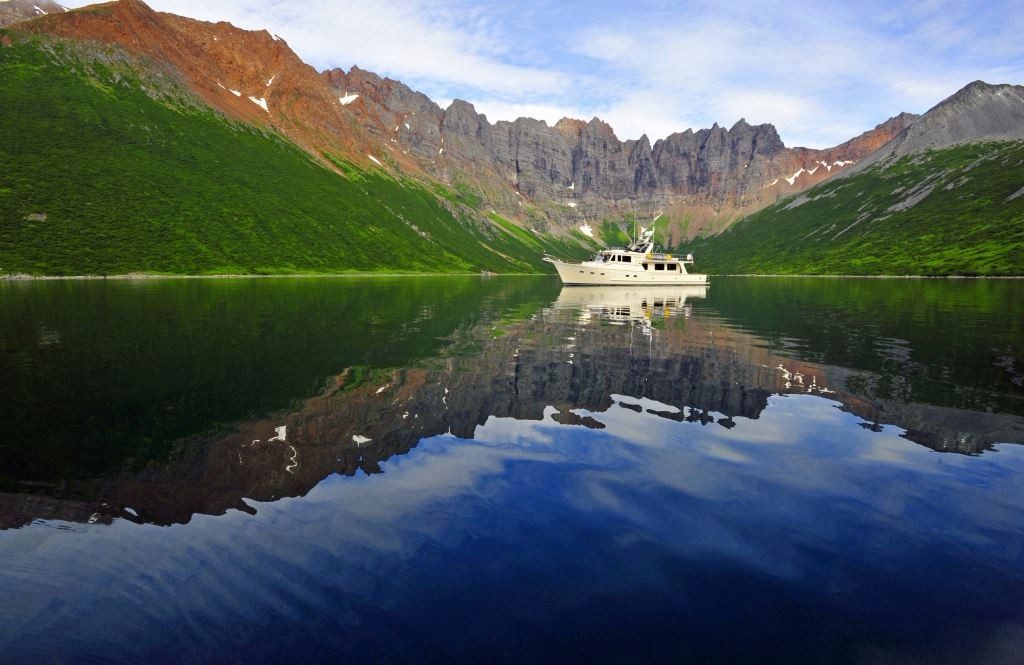
Venture, a Fleming 65, rests at anchor in Castle Bay, on a sun-drenched Alaskan day.
Alaska’s license place motto, “The Last Frontier” isn’t just one of those catch phrases, it’s accurate, Alaska truly is wild and undeveloped, as I discovered during a month-long, 1,500 mile passage from the far western peninsula island port of Sand Point, to Sitka, located on the Southeast coast.
When I travel to remote locations, to cruise with clients or friends, I nearly always fly in and thus invariably my first glimpses of a region are from the air, and the Alaskan Peninsula is no exception. I’m meeting the vessel aboard which I will cruise, Venture, a Fleming 65 owned by company founder Tony Fleming, in Sand Point, which is on Popof Island, located off the south side of the far western end of the Alaskan Peninsula.
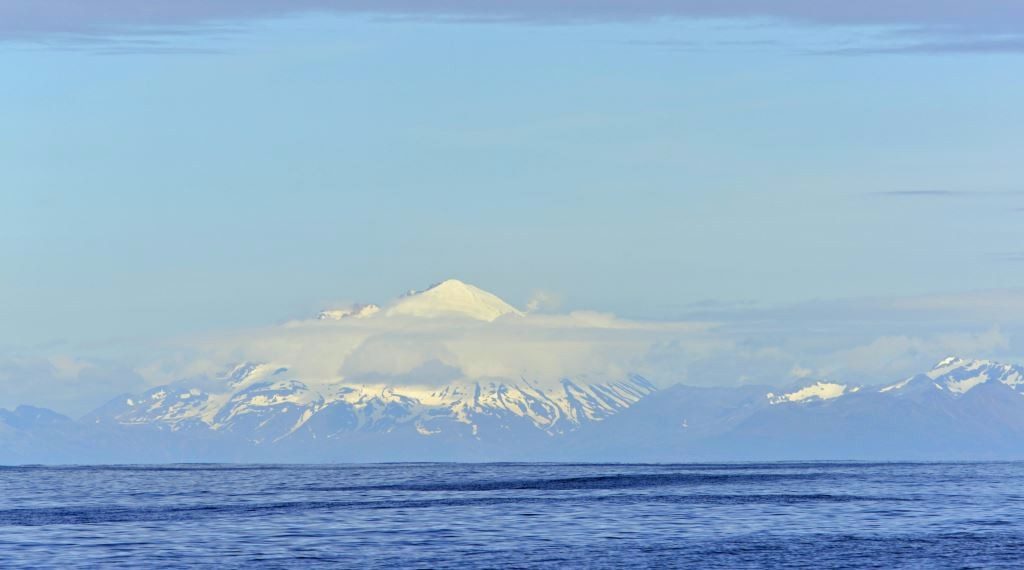
Part of Alaska’s Aleutian Range, which stretches from Chakachamna Lake in the east to to Unimak, at the far western end of the Aleutian Islands.
Weather in this region, which is bordered by the North Pacific to the south, and Bering Sea to the north, is fickle at best (it’s often, and accurately, depicted on the reality TV program, “Deadliest Catch”, which is filmed not far from here); not until just eighty miles from my destination, during a 500 mile flight that began in Anchorage, do a catch a fleeting glimpse of the terrain, a large bay on the Bering Sea side, fed by miles of estuaries, including the Meshik River, and endless swaths of marsh land. A finger of land, Strogonof Point, Russian place names are a theme throughout coastal Alaska, runs along the mouth of the bay. The visage, through holes in the otherwise blanket-like cloud cover, is only momentary, lasting no more than 30 seconds. The prior day I make this same flight, only to turn back after circling the fogged-in island for half an hour. From my seat located in the far aft of the cabin, which I choose for the view of the ground, I watch ice form on the leading edge of the elevator, then break off as the deicing system kicks in; then I catch a second glimpse of the land below, snow studded peaks, and black craters, volcanism is yet another theme common to the area, and then a flood of lakes, and verdant rolling tundra. It’s pure and unspoiled; there are no roads, no man-made structures, and no sign of human habitation.
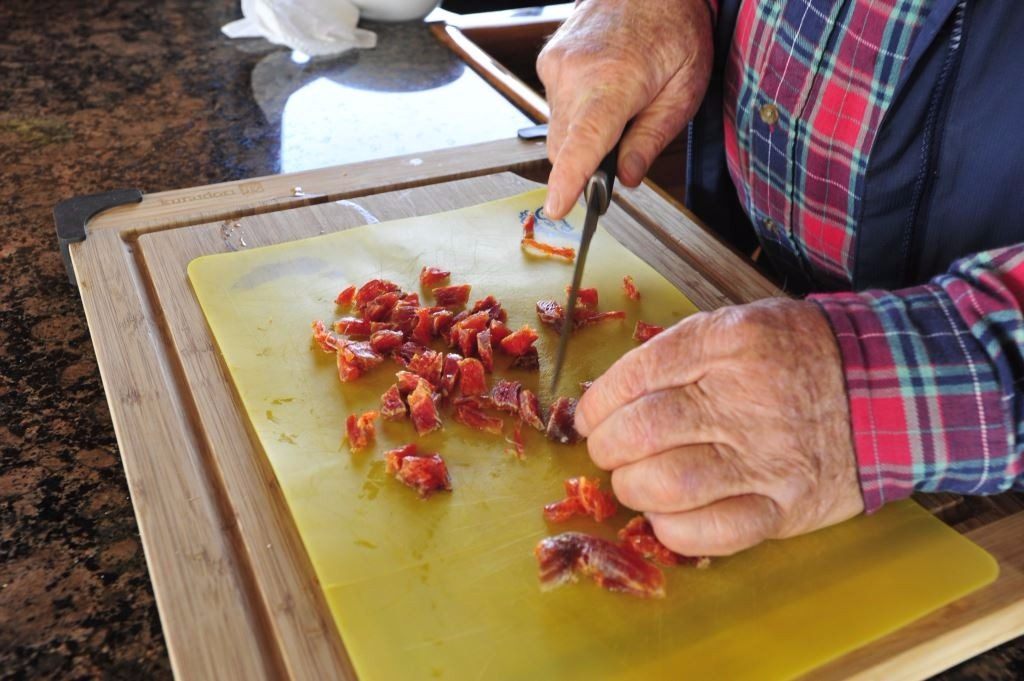
Among many other things an accomplished cook, Tony Fleming prepares a salmon dish in Venture’s galley
At nearly 34,000 miles, the state of Alaska holds the distinction of possessing the nation’s longest coastline. One could cruise its south coast alone, season after season, and never anchor in the same cove, harbor or bay twice. Having cruised here before, I believed I had some idea of what to expect from this passage, however, I was entirely unprepared for the utter remoteness and sublime desolation of the Peninsula and its off lying islands. It’s a region to which few cruising vessels venture and with good reason, its coastline is exposed to the North Pacific’s unremitting swell, and sudden weather changes, and settlements, provisioning, spare parts and other necessities are few and far between, as we would later discover. Additionally, cellular and internet service is, with few exceptions, non-existent, and even VHF weather is absent in many locations. It’s no accident, however that I’m on this passage, as this is precisely the type of cruising I prefer.
In addition to myself there are three others aboard Venture, Tony Fleming; Chris Conklin, the vessel’s experienced and long-time captain; and fellow guest Christine Edwards. Venture’s passage began in April in Sydney, British Columbia, I’ve been invited to hitch a ride for the month of July, as she makes her way back east along the Alaskan Peninsula, to Kodiak Island and then across the Gulf of Alaska to Sitka, where I disembark and join another vessel, a Nordhavn 63 named Piredmus. Having cruised previously aboard Venture in Alaska’s Prince William Sound, and in Iceland, the vessel, her crew and routine is familiar and comfortable, and I’m made to feel at home.
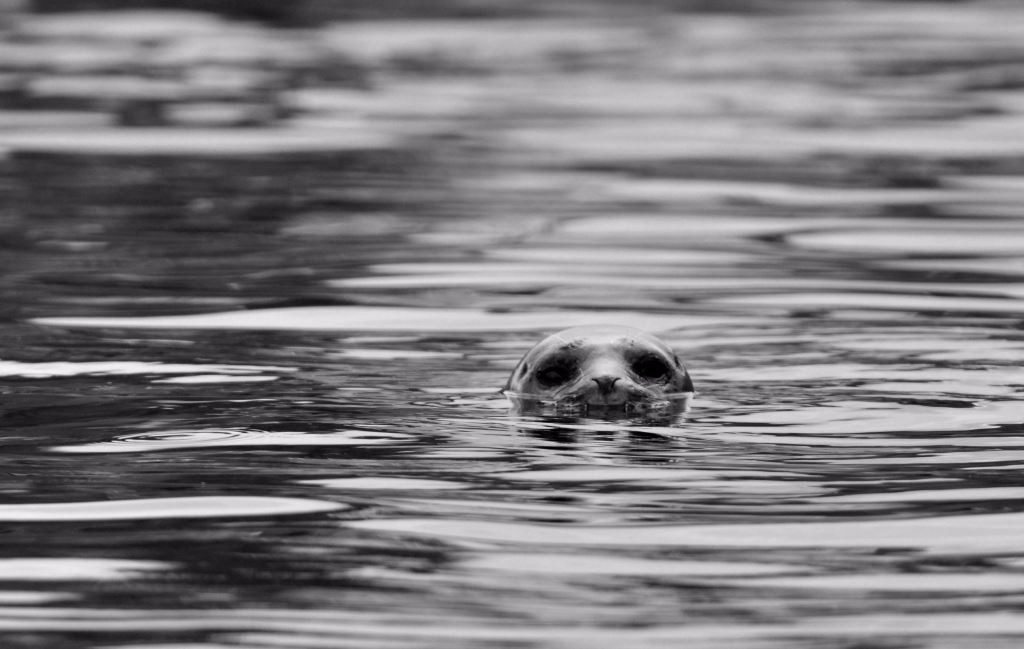
A stellar sea lion pops up for a quick look in Kodiak Island’s Olga Bay.
Because of the high latitude and far west longitude (and single time zone for all of Alaska) the sun doesn’t set until nearly midnight. As tired as I am, and as accustomed as I am to high latitude cruising, I have trouble heading off to my bunk with the sun still visible. I sit at the saloon table and respond to e mails, which I send using the Iridium GO! communication device I’ve rented from the SatPhoneStore. With data speeds similar to dial-up, it’s anything but rapid, however, it enables me to remain in continuous contact with my office, family and magazine editors while in far flung, off the grid locations like this.
During my short stay in Sand Point the crew takes the opportunity to provision at the local grocery store, a fixture, thanks to the fishing fleet, in even the smallest seaside towns. While walking from the harbor I encounter a small white church, whose belfry is topped by a Russian Orthodox cross. A trio of ravens roosts under its overhang. Much of Alaska’s coast was explored and occupied by Russia between 1733 and 1867, leaving behind a legacy of geographic place names and religion, with the latter still actively observed in many Alaskan coastal towns. Still, the profusion of islands, harbors and rivers bearing Russian names, and Orthodox churches and grave yards somehow seem incongruous.
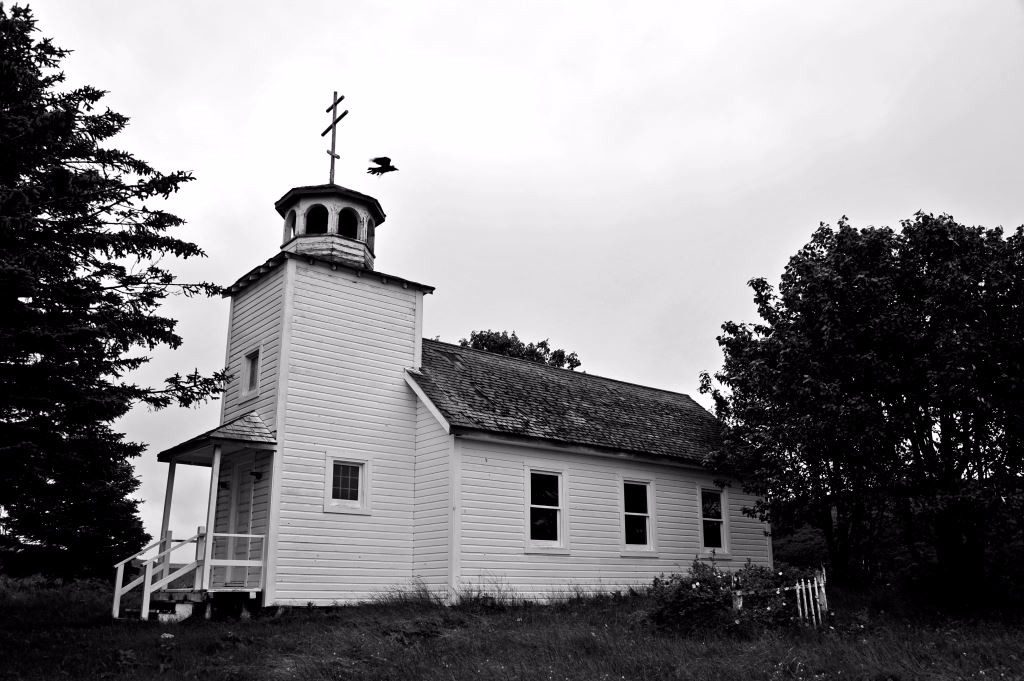
Russian Orthodoxy, and the associated churches and graveyards are common in southwest Alaska
The harbor here is well –protected and equipped with large, modern floating docks, fuel, repair facilities and a 200 ton Travelift. It, like many of the settlements along Alaska’s coast, is dedicated entirely to the support of the fishing fleet and fish processing industry. The slips are, however, all but empty, and of the few vessels that are dockside, many are being serviced or repaired, and nearly all are immaculately maintained, at least by fishing vessel standards.
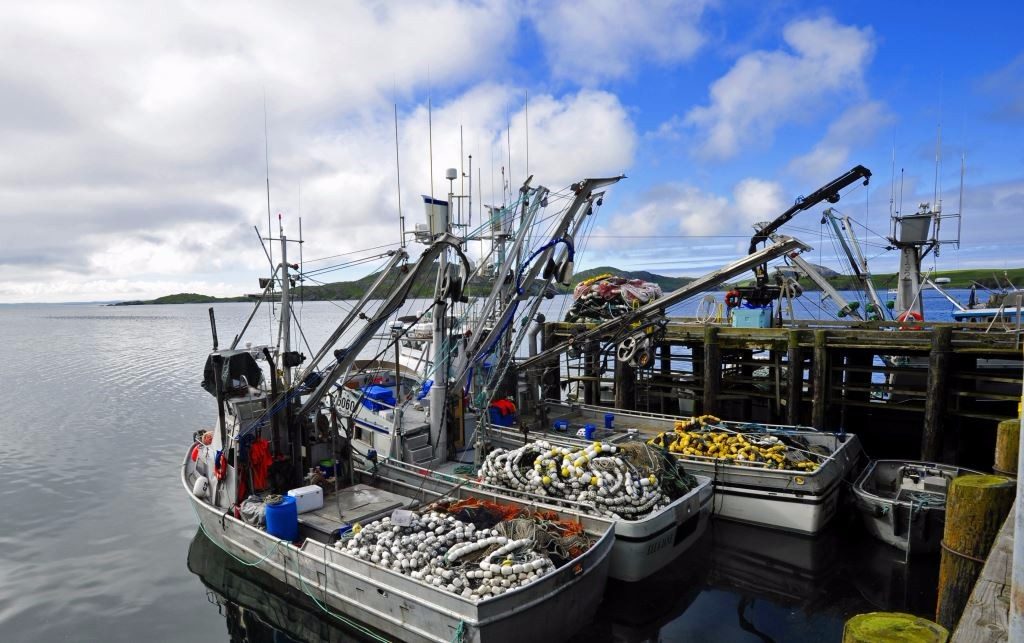
Fishing vessels await the next Salmon opening at the Alitak cannery on Kodiak Island.
Castle Bay, one of Ventures early stops after departing from Sand Point, lives up to its name as we drop anchor in the northwest arm, in the shadow of sheer 3,000 foot cliff faces, the peaks of which, enshrouded in snow and mist, are only partially visible. Blue sky has made occasional appearances, with patches continuing to grow as the hours pass. A chill katabatic wind funnels down and through the canyon-like walls, as lone eagle circles over us; outside the sound of dozens of waterfalls create nature’s own white noise. These waterfalls cascade down the mountainside, yet few visibly enter the sea, in most cases they are swallowed by rocky, porous ground, where they disappear. Periodically great rumbles can be heard, the sound of boulders falling from great heights. Black and white murres bob and kittiwakes circle the boat, the former routinely disappearing to hunt for a meal.
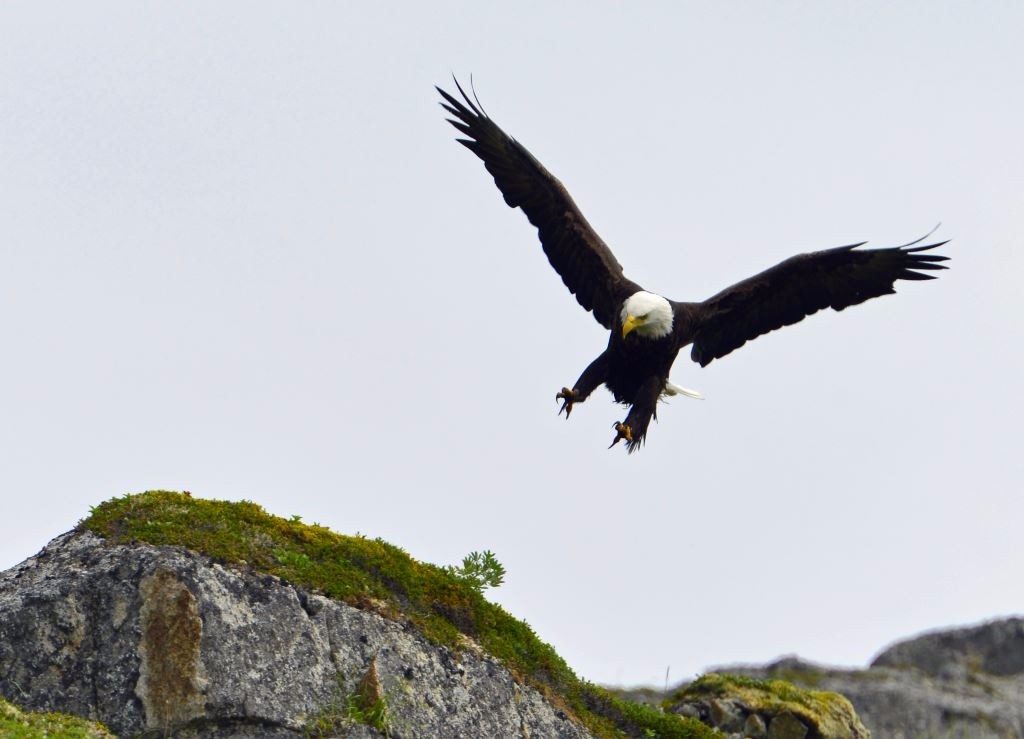
An eagle prepares for a landing on an outcropping at remote, uninhabited Sutwik Island.
Contrary to the weather forecast the following morning dawns clear, the cliffs are free of mist, they are back-lit by a brilliant cerulean sky, the winds have abated, and the arm’s surface is as smooth as polished slate. We take the opportunity to launch the tender and conduct a photo shoot, using the cliffs as a backdrop. We also launch Venture’s drone for aerial photos both at rest and underway, after which we make for our next stop, remote Sutwik Island, located ten miles off the peninsula’s coast.
The passage is exceptionally calm, with bright sun, and billowing white clouds; jagged black volcanic islands drift by as we glide over an oily sea. Within half an hour of reaching the open sea we encounter a pod of Dall’s porpoises. Found only in the North Pacific; with their distinctive black and white coloration, they look like miniature killer whales. They are on a reciprocal course and are gone in an instant, however, they do an about face and race back to our bow, where they remain for several minutes arching and blowing just ahead of Venture’s stem. I’ve seen dolphins at sea and in the bow wave many times; Dall’s, however, are larger and very energetic, they are renown as the fastest swimmers of all small cetaceans, capable of reaching speeds of 30 mph. On several occasions later in the passage we encounter them in open ocean, their dorsal fins streaking through the water leaving ‘rooster tails’, making impossibly sharp turns and periodic broaches as they chase prey.
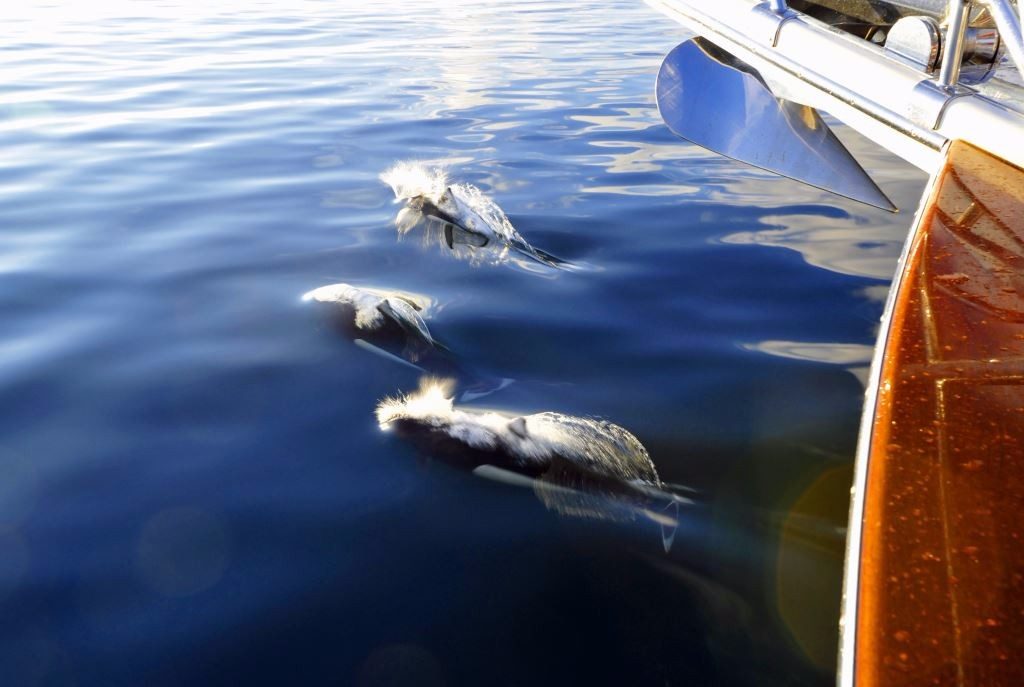
Dall’s porpoises ride ahead of Venture’s bow wave. Normally shy, this trio made a 180° turn to swim along with us for a few minutes.
By 3:00 pm we’re anchored in a bight along Sutwick’s north side, off a long but narrow sandy beach at the base of steep, rusty red cliffs. Above the cliffs it’s all green turf and low bushes, while the beach is littered with massive piles of drift wood, much of which is thought to originate in Siberia. Sutwik, and much of the land and islands along the Peninsula are free of forest, the only trees are the scattered clumps planted by settlers.
The rock faces on the beach are loose; almost any rock can be dislodged from a seemingly solid pillar of stone, making climbing both difficult and dangerous. Wanting a higher vantage point from which to view the island, I hike into the interior by climbing up and adjacent to a small waterfall; the rocks seem slightly more stable here. Once inland I encounter steep hills and meadows, all with low grass and thick underbrush. I am, as always when going ashore in Alaska, alert for the bears, I keep a sharp lookout, while being sure to make plenty of noise as I go. I encounter no bears; however, I first hear their distinctive ‘peeps’, and then spy an eagle pair circling over a nest located on a promontory that protrudes out into the sea on the windward side of the island. I make my way to within about 100 yards and simply lie down in the grass and watch the two wheel and soar overhead, it’s mesmerizing.
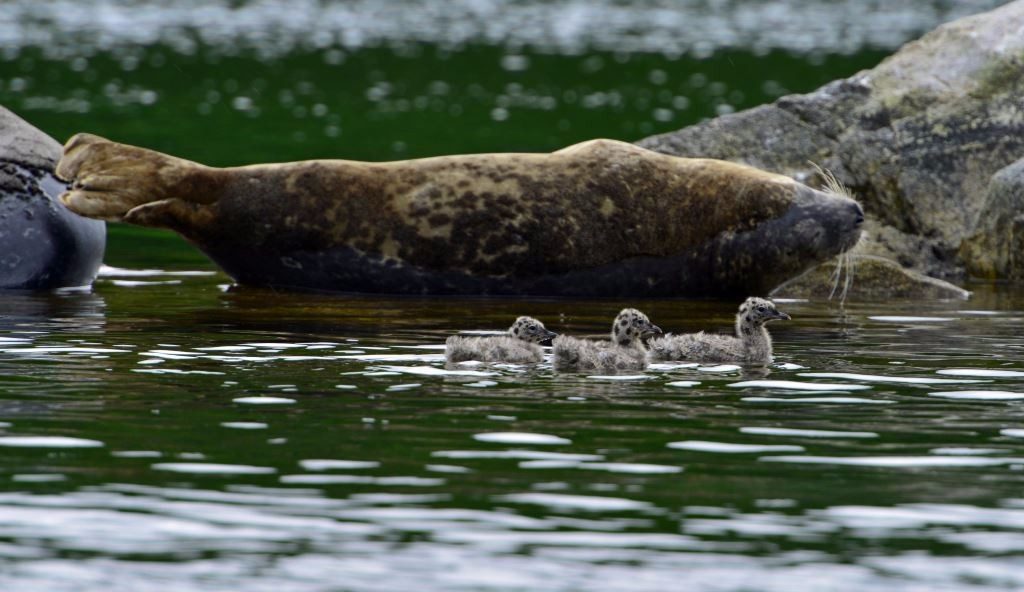
Abundant wildlife is a hallmark of the region, and in early summer hatchling birds abound.
After staying at Sutwik for a few hours Venture weighs anchor and makes her way east along the coast, eventually stopping at Lazy Bay, our first landfall on Kodiak Island. The bay is home to Alitak Cannery, and this is a real cannery. While the vast majority of fish processing plants in this area freeze fish and ship them out in containers, Alitak still cans them the old fashioned way, and has been doing so on this site since 1917. We stay for two days and the visit turns out to be among the most memorable during the passage.
A lenticular cloud hangs over the hills behind the cannery, and the bay is glassy calm. We launch the tender and make our way ashore for a visit. Cruising guides and another cruiser tell us Alitak is not to be missed, yet provide few details as to why, other than to say, “Be sure to meet the plant manager, Woody Knebel, and see his museum and photo album”. From a distance the facility looks neat and clean, however, up close it could pass for a military installation. From the moment we set foot on the dock it’s clear this fish processing plant is cut from a different bolt. I’ve visited many of these and most range from messy to downright repulsive, in some cases I’ve been driven out of an anchorage by the smell of rancid fish alone. Not only is there no odor what so ever, this plant is whitewashed from top to bottom, there’s no trash to be seen anywhere, and nothing is out of place.
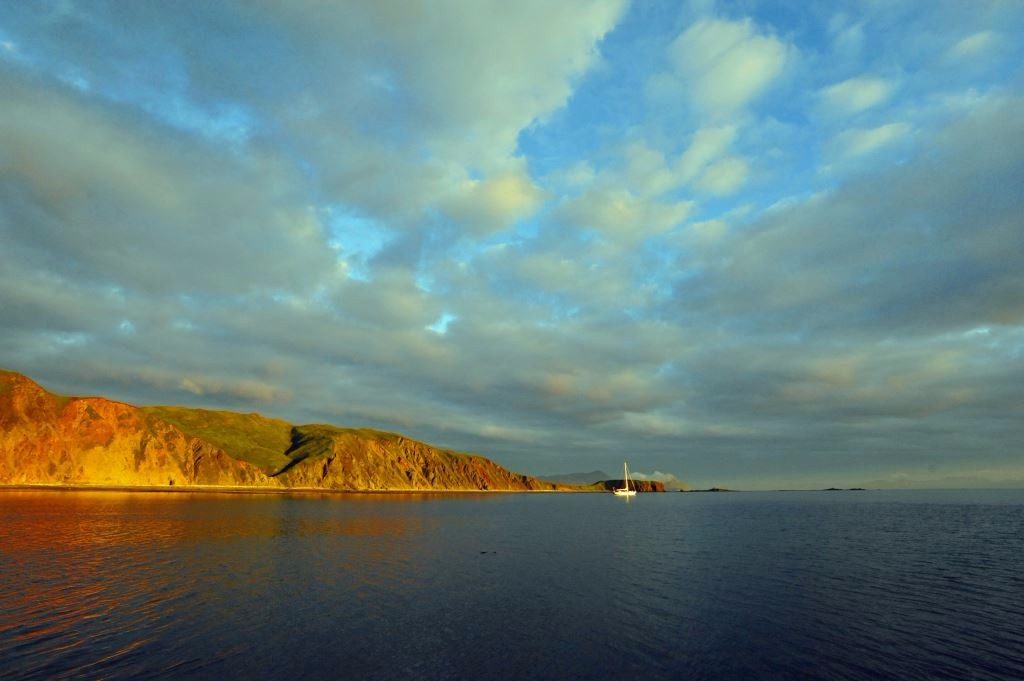
Cruising vessels are a rarity in the western part of the Aleutians. Those we encountered were manly sailboats.
We meet Woody, a boyish-faced, affable 40ish fellow, in his compact office, which is a miniature shrine to Kodiak wildlife, natural history and native populations; it’s chockablock with artifacts, antiques and fossils. After chatting with him for a while he offers to give us a tour, during which he proudly walks us through the entire facility, including the “museum” a room he’s created, and which houses an astounding variety of artifacts, from an entire 100 year old wooden fishing dory to antique fish processing equipment and a small restored and functional steam engine (which he demonstrated with plumbed in compressed air). Other areas include the diesel generator electric plant, it’s immaculate, a woodshop, metal shop and the heart of the facility, the canning operation. There’s even a small chapel, also Woody’s doing, isolated on a hillside, it’s ringed by memorial crosses from revered deceased employees and pets. At the opposite end of the “camp” another memorial, a plaque which carries a poem, pays tribute to two fishermen from the plant who were lost while working from a small boat two decades ago.
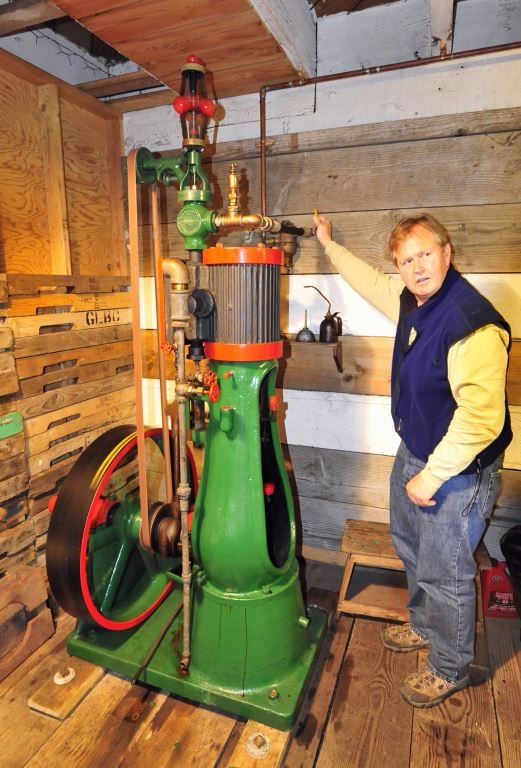
Alitak cannery manager Woody Knebel demonstrates his restored steam engine, which operates off the cannery’s compressed air system.
Woody is an accomplished photographer, his photos adorn the walls of his office and many other rooms throughout the facility. Making over 70 trips to nearby granite outcroppings, over the course of ten years, he’s managed to photograph and draw a series of ancient petroglyphs, waiting for the right, low angle lighting to capture each set, and about which he’s written a book, “The Cape Alutiiq Petroglyphs”. He’s also a gifted raconteur, sharing both stories of his own as well as others that have passed through. He’s managed this plant for 17 years and has seemingly seen it all. As we walk the neatly groomed paths between buildings Woody stops occasionally to pick up scraps of paper or cigarette butts, and not without some effort as he’s afflicted with Parkinson’s disease. He’s clearly proud of the facility he keeps. He’s also clearly well-respected by the staff, they all greet him warmly. He tells us the cannery’s season is five months long, and 100 hour weeks aren’t unusual, when the fish are in season, primarily salmon, “we never stop working” he says.
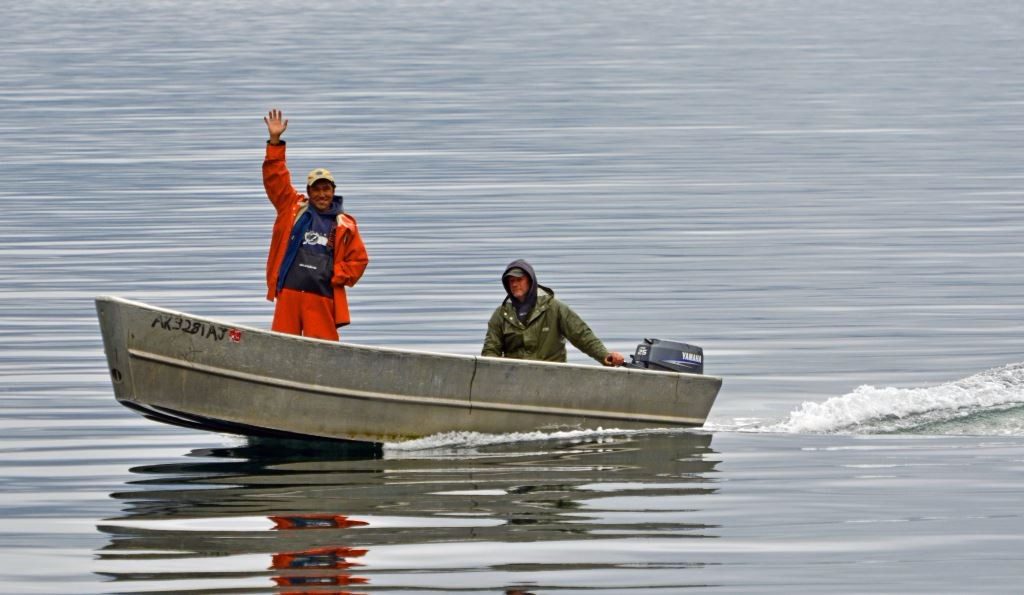
Fishermen in the region use a range of vessels for their work. These men are on their way to tend shore-gill nets.
We’re invited to stay for lunch in the “executive dining room”, a small room off the main dining hall. The fare is hearty and delicious, soup, fresh baked bread, roasted pork, hamburgers, with melon, chocolate cake and ice cream for dessert. I walk through the main dining room where roughly 200 employees eat, the food is identical. The large table on which we eat is made from packing crates and other scrap lumber, it oozes character, as each color that’s etched into it tells a story of a different caned brand, Star-Kist, Bumblebee, Alitak and others.
As we leave we walk by dozens of fishing boats piled high with fish gear, much of it being worked on by crews, nets are being repaired, hulls painted and hydraulic machinery serviced. It’s a hive of activity that operates in high gear during the long summer days, which then falls dormant during the long, bleak winter months.
Next month the journey continues with explorations of Kodiak Island, a seaplane journey to a high lake to view grizzlies feeding on spawning salmon, and crossing the Gulf of Alaska.



